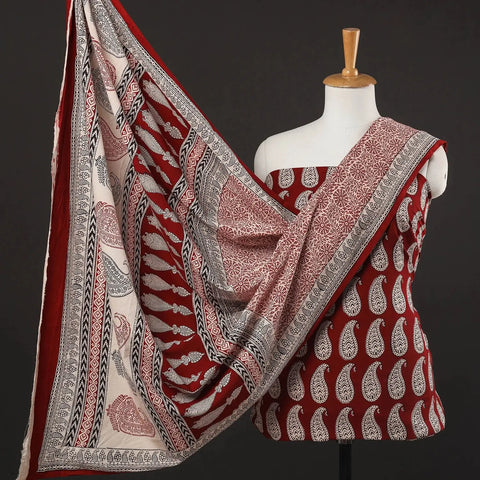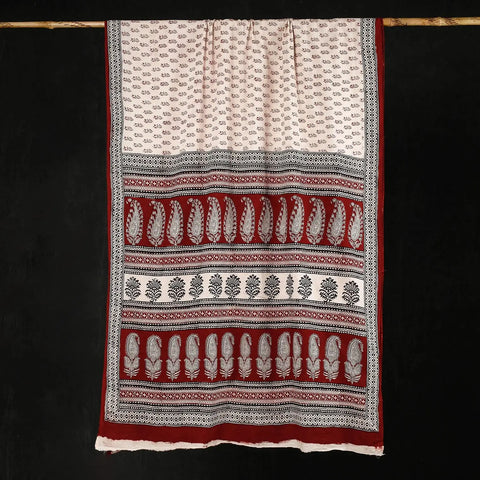Madhya Pradesh located in central India, is known for its rich artistic and architectural heritage. Bagh print is a traditional Indian technique that uses wooden blocks and naturally produced dyes. The Bagh printing process is an old textile printing technique that finds its genesis in a village called Bagh which is located in the Dhar district of Madhya Pradesh. (1)
It is colloquially known as Thappa Chappai.
Origin & History of Bagh Printing
When we talk about the history of Bagh printing, we are taken back to 3000 BC. Archaeologists believe that India is the birthplace of textile printing as we know it. In 1960 AD, Khatris Of Bagh were able to deduce that the high content of copper in the Baghini River in Madhya Pradesh could deepen the colour of the fabric. The Bagh prints of Madhya Pradesh are made up of delicate floral motifs that are neatly contrived in symmetry.
What is Bagh Print
Bagh block printing is a largely manual process and even the materials used for carrying out the Bagh print are handmade. This technique involves the usage of wooden blocks that are made from teak wood. These wooden blocks feature elaborate motifs and patterns for printings. Bagh print usually involves the use of red, maroon and black vegetable dyes on a white base on which vibrant designs are embossed. However, over the years, Khaki and mustard colours have also started getting used. From Bagh print dupattas to Bagh dress materials today you have a plethora of options in the Indian fashion space.

Materials Used In Bagh Block Printing
The following materials are used in traditional Bagh Block printing:
- A range of fabrics such as cotton, silk, chiffon, etc.
- The wooden engraved blocks with desired designs.
- Rock salt which is also known as cenchura
- Castor oil which is also known as aarandi ka tel
- Grounded excreta of goat (mengani)
- Fitakari which is also known as alum
- Iron Sulphate
- Dhavda flowers
- Alizarine to hold the colours in place.
Process of Bagh Printing
Let us explore the process of Bagh Printing in detail:
The Bagh printing process involves the following stages:
-
Pre Printing Stage
- Firstly, the fabric on which Bagh printing has to be done is washed in running water for a few hours. The fabric is beaten against a stone to ensure that starch is completely removed as the presence of starch can cause problems in the dyeing process.
- After that, the fabric is soaked in a special solution made from rock salt, castor oil and goat excreta (mengani). This process is called Mengani Karna where the artisan washes and rinses the fabric three times in the Bagh river.
-
Printing Process
- The cloth is then pre-dyed with a solution called Harda that gives an off-white base for the colours of the Bagh print to shine through.
- Artisans use 200-300-year-old wooden blocks known as Bilal (2) that are dipped in natural dyes for the Bagh print. The dyes are kept in a wooden container called palea to ensure that appropriate dyes can be picked up for the printing process. The blocks are mounted on a bamboo mesh covered in wool known as Kartali. The Kartali is allowed to float on water so that it soaks up the dye and transfers it to the printing block when rested on top of it.
- The artisans pay articulate attention to ensure the prints are made in a symmetrical and precise manner and therefore, it takes approximately two weeks for the entire manual printing process to come through
-
Post Printing
- Post the printing process, the fabric is taken to the Bagh River, where it is washed and beaten against stones to get rid of excess dyes.
- The fabric is then put through a process known as the Bhatti technique. The technique involves the boiling of fabric in a solution made of alizarin, Dhavda flowers and water. The fabric is constantly with sticks in the boiling solution to ensure the proper setting of dyes. The whole process can take nearly six hours and requires repeated washing and bleaching of the fabric in this manner.
You Might Like Reading:
Artisan In Focus: Interview With Artisan Umar Faruk Khatri
What is the difference between natural dyes and chemical dyes?
Explore The Breathtaking Beauty of 5 Unexplored Indian Heritage Sites
Conclusion
Bagh printing fabrics embody the rich heritage, cultural significance and outstanding craftsmanship of Madhya Pradesh. This precious art form continues to thrive in the heart of India; Madhya Pradesh and its beauty is much sought after by people across the country.
iTokri has an interesting range of Bagh printed sarees, that are brought to you directly from the artisans of Madhya Pradesh. so what are you waiting for? Get your hands on these gorgeous Madhya Pradesh handicrafts and elevate the charm of your collection. For authentic Indian Handicrafts online, you can always rely on iTokri.

FAQs on Bagh Block Printing
-
Is Bagh printing a laborious process?
Yes. Bagh printing is a very laborious process that requires a lot of time, skin and precision. There are multiple steps involved in the Bagh printing process and each step requires articulate time and attention.
-
How many days does it take to create a Bagh Printed fabric?
It takes nearly two weeks for bagh printed fabric to be ready for the market.
-
Bagh Printing is from which state?
Bagh Printing originates right from the heart of India; Madhya Pradesh.
 Verified Purchase
Verified Purchase











































































































































































































Leave a comment (all fields required)